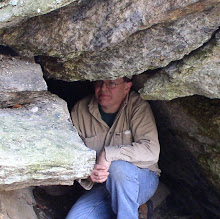This likely will finish out an (all too) abbreviated season. It is with cautious optimism, I'll look forward to another Spring. No doubt about it - it will be a difficult time during the coming months for our Country
The Rhody Mountain Man (occasionally known as Mike) descended upon the Berkshires as we joined forces in Western Pittsfield. Once upon a time, a small cave existed here but recent years have seen a new housing development likey bury it. The area we explored is underlain (to some degree) by marble providing us with a rudimentary karst area. Nothing we would expect to produce any great rewards. Like another cave or other major karst features.
After looking over a couple of resurgences, we trekked out into more remote locations where Mike's research, using LIDAR, foretold of possible sinkholes. And sinkholes, indeed, we did find! Interesting, but again, nothing major. Small signs of possible drainage and almost no bedrock outcrops. Perhaps most interesting was a drainage gully that produced a mini cave-like formation. Marble was present at this site but intermingled with other surrounding rocks.
Trucking out from the woods, we decided to relocate to the southern parts of Pittsfield to visit a cave that found its history among the famous books by Clay Perry. Elsie Venner's Cave is named after the story by Oliver Wendell Holmes and rests high in mountainous ledges that require a bit of a difficult climb. I visit this cave every few years but it was an opportunity for RMM's first visit. The cave is a chamber under rocks fallen from a higher elevation. There is even a side exit passage under an enormous boulder that has fractured. Photos taken, we returned to our cars to part ways on this particular trip. Likely, it will be springtime before I meet up with Mike once again!





































